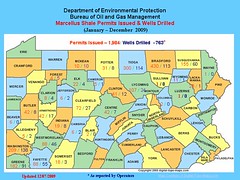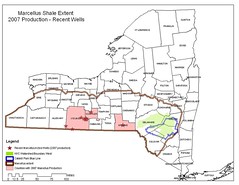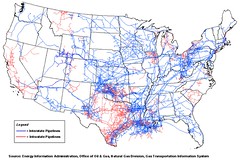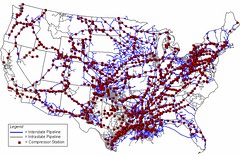July 13, 2010- The Pennsylvania Environmental Council (PEC) released a report calling for swift action on new regulations and greater oversight of drilling and extraction of natural gas from the Marcellus Shale formation, a major gas field that lies deep beneath much of Pennsylvania.
Called "Developing the Marcellus Shale," the report challenges state government and the natural gas industry to adopt more stringent standards for drilling and extraction to prevent the kind of environmental impacts that have occurred throughout Pennsylvania's industrial past.
The report also includes a number of specific legislative and regulatory changes that PEC believes should be made to minimize the risk of accidents, environmental damage, and public health hazards stemming from drilling operations.
DOWNLOAD Developing the Marcellus Shale
Beneath the Surface: A Survey of Environmental Risks from Shale Gas Development | Worldwatch Institute
7/16/2010Washington, D.C.- Improved drilling techniques have unlocked vast new reserves of shale gas, a resource that could be large enough to displace significant amounts of coal, and an energy source that emits less than half the carbon dioxide. But growing shale gas development has raised both environmental questions and public controversy. A new independent assessment by the Worldwatch Institute concludes that improved adherence to drilling best practice and better regulatory oversight are essential to assure environmental and public protection as shale gas production continues to expand.
The report, Addressing Environmental Risks from Shale Gas Development, details what happens beneath the surface during horizontal drilling and hydraulic fracturing in deep shale formations, evaluating the risks to local water quality and the environment, as well as the technologies and policies needed to overcome them.
"Microseismic data have shown us that a properly designed hydraulic fracture job stimulates gas production only within the shale formations, which are typically hundreds of feet thick and thousands of feet deeper than drinking water supplies," says Mark Zoback, a geophysicist at Stanford University and a report co-author. "For this reason, the risk of fractures propagating from deep shale formations to underground sources of drinking water, which has been the subject of much debate, appears to be extremely low."
The report concludes that faulty well construction, in particular poorly cemented steel casings needed to isolate the gas from shallow formations, as well as above-ground contamination due to leaks and spills of fracturing fluids and waste water, pose more significant risks to the environment. In addition, continued study and improved communication of the environmental risks associated with both individual wells and large scale shale gas development are essential for society to make well-informed decisions about its energy future.
"Although the technologies, best practices, and regulations that can help minimize these risks exist, they have not yet been universally adopted," says Worldwatch Fellow and co-author Saya Kitasei. "Experiences in Colorado, Wyoming, Pennsylvania, and New York demonstrate that strong public pressure exists for stricter oversight."
The report, authored by Mark Zoback of Stanford University, Saya Kitasei of the Worldwatch Institute, and Bradford Copithorne of Environmental Defense Fund, is the second in a series of briefing papers from Worldwatch's Natural Gas and Sustainable Energy Initiative, which examines critical environmental and policy issues surrounding natural gas.
Download Addressing Environmental Risks from Shale Gas Development by Mark Zoback, Saya Kitasei, and Bradford Copithorne.
DEMAND ACCOUNTABILITY!



















No comments:
Post a Comment